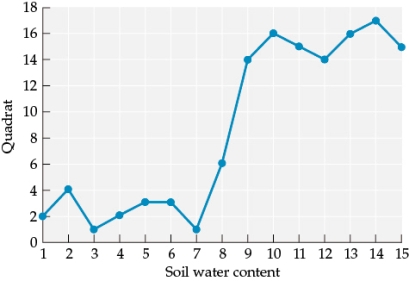Refer to the table and the figure.
Table 1
 Figure 2
Figure 2
 Suppose you are researching an ecological community in a new study area. You divide your study area into quadrats and sample one quadrat a day to determine the species that occupy the area and how many individuals of these species are present. Assume that by the end of your sampling efforts, you have identified all of the species that occur in the study area. Suppose that in addition to finding individuals and identifying species, you also collect information on abiotic factors and environmental conditions in the study area. Figure 2 shows how abiotic factors vary across the quadrats sampled. Based on your samples of the numbers of individuals of each species that occur in these quadrats (Table 1), which species is most affected by quadrat-level differences in soil water content? Based on both Table 1 and Figure 2, how would you define communities and determine the number of communities in your study area? How might this information influence how you categorize your quadrats into communities?
Suppose you are researching an ecological community in a new study area. You divide your study area into quadrats and sample one quadrat a day to determine the species that occupy the area and how many individuals of these species are present. Assume that by the end of your sampling efforts, you have identified all of the species that occur in the study area. Suppose that in addition to finding individuals and identifying species, you also collect information on abiotic factors and environmental conditions in the study area. Figure 2 shows how abiotic factors vary across the quadrats sampled. Based on your samples of the numbers of individuals of each species that occur in these quadrats (Table 1), which species is most affected by quadrat-level differences in soil water content? Based on both Table 1 and Figure 2, how would you define communities and determine the number of communities in your study area? How might this information influence how you categorize your quadrats into communities?
Correct Answer:
Verified
View Answer
Unlock this answer now
Get Access to more Verified Answers free of charge
Q44: Alsterberg and colleagues showed that with ocean
Q45: Which technique was used to determine the
Q46: Refer to the table.
Table 1

Q47: Refer to the tables. Q48: Refer to the tables and figure. Q50: Refer to the table. Q51: Refer to the tables and the figure. Q52: Refer to the table and figure. Q53: Refer to the tables. Q54: Refer to the table.
![]()
Table 3: Species Abundance
![]()
Table 9

Unlock this Answer For Free Now!
View this answer and more for free by performing one of the following actions

Scan the QR code to install the App and get 2 free unlocks

Unlock quizzes for free by uploading documents